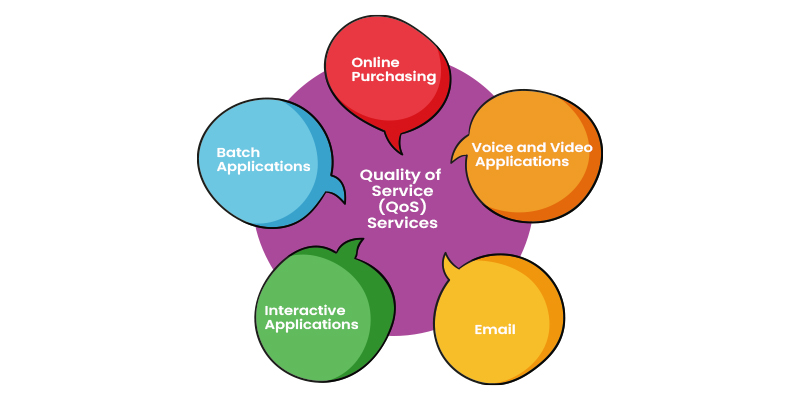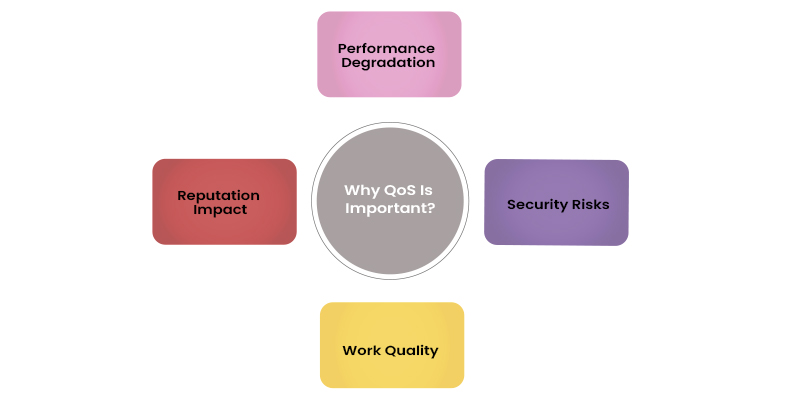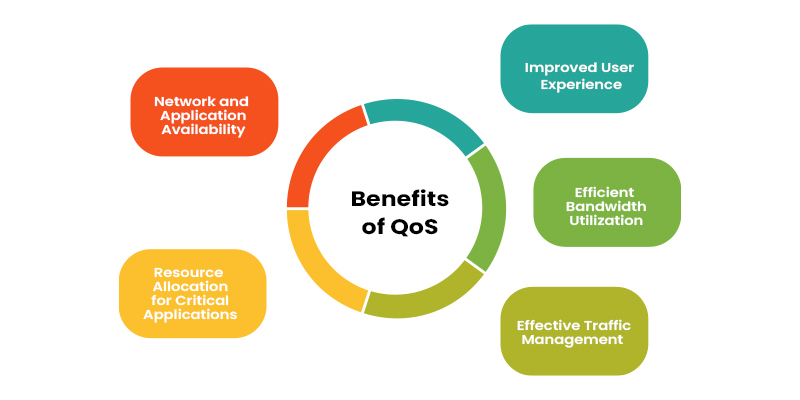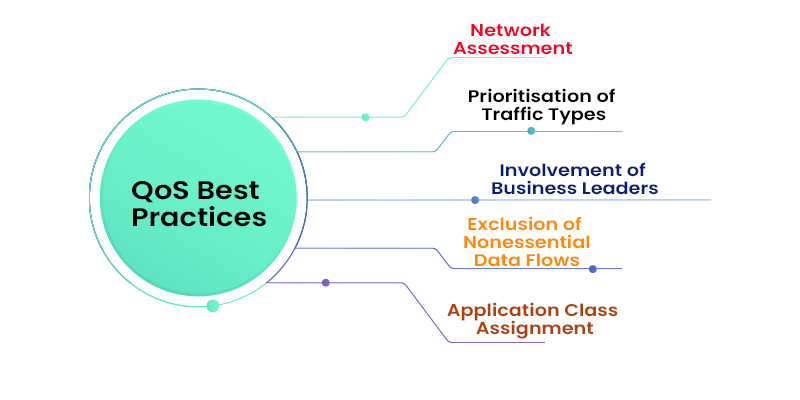
Quality of Service (QoS) encompasses a suite of technologies designed to ensure the reliable execution of high-priority applications and traffic within a network, even when faced with limited network capacity. The primary goal of QoS technologies is to deliver distinctive treatment and allocate capacity to specific flows in network traffic. This capability empowers network administrators to determine the prioritization of packet handling and allocate bandwidth to particular applications or traffic flows.
QoS mechanisms come into play in scenarios where network congestion or limitations could potentially impact the performance of critical applications. By implementing QoS, network administrators can strategically manage and optimize the handling of diverse traffic types, ensuring that essential services receive the necessary resources to function effectively. This involves establishing policies and mechanisms to prioritize certain data packets, regulate latency, and manage bandwidth allocation based on the specific requirements of applications or services. For those interested in fortifying their skills in networking and addressing security considerations, considering enrolling in reputable Cyber Security Training in Chennai can provide valuable insights and skills. This educational opportunity equips individuals with the knowledge to navigate the complexities of network security while optimizing Quality of Service measures for enhanced performance and reliability.
Types of Traffic on the Network

Quality of Service (QoS) involves the measurement and management of several key parameters related to network traffic. These measurements are essential for ensuring the efficient and reliable performance of different applications and services. The critical traffic types that QoS focuses on include:
Bandwidth (Maximum Rate of Transfer): Bandwidth refers to the maximum data transfer rate of a network link, often expressed in bits per second (bps). It signifies the speed or capacity of the link, determining how much data can be transmitted within a given timeframe.
Throughput (Actual Rate of Transfer): Throughput represents the actual rate of data transfer on a network, indicating the real-world performance. It is the measure of how much data is successfully transmitted over the network and is influenced by factors such as network congestion, errors, and retransmissions.
Latency (Delay): Latency measures the delay or time it takes for a data packet to travel from its source to its destination across the network. Low latency is crucial for real-time applications, and different types of traffic may have varying latency requirements.
Jitter (Variance in Latency): Jitter is the variability in latency, specifically the variance in the arrival times of data packets. Consistent and predictable latency is important for applications like voice and video, where jitter can lead to poor quality and disruptions.
If you want to know more about the latest salary trends for Networking developers, Check out Networking Interview Questions and Answers, which will help you get an insight into the different types of interview questions and discuss the critical topics.
Quality of Service (QoS) Services
Quality of Service (QoS) plays a crucial role in optimizing network performance for various applications and services. It is particularly key for the following types of applications:

Voice and Video Applications: Real-time communication applications like Voice over IP (VoIP) and video conferencing demand low latency and minimal jitter to ensure clear and uninterrupted audio and video transmission.
Email: While email applications may not require real-time performance, ensuring reliable and timely delivery of email messages contributes to a positive user experience.
Interactive Applications: Applications that involve user interaction, such as online gaming or remote desktop access, benefit from low latency to provide a responsive and seamless user interface.
Batch Applications: Batch processing applications, which involve the bulk processing of data, can benefit from appropriate bandwidth allocation and prioritization to maintain efficiency.
Online Purchasing: E-commerce and online purchasing platforms require a responsive network to provide users with a smooth and reliable shopping experience. QoS helps ensure that transactional data is handled efficiently.
For inelastic applications like VoIP and video streaming, where the sensitivity to latency and jitter is high, QoS policies become essential. These policies help prioritize such traffic, allocate necessary bandwidth, and minimize delays, ensuring a consistent and high-quality experience for users engaging in real-time communication or accessing multimedia content. In summary, QoS enables the effective management of network resources to meet the specific requirements of different applications and enhance overall user satisfaction.
How QoS Technologies Work?
Quality of Service (QoS) is a vital aspect of network management, ensuring the efficient and prioritized transmission of data packets across the network. In the analogy of network packets to letters in envelopes, QoS acts as the system that organizes and prioritizes these packets to maximize the available network bandwidth. The primary objective is to allocate bandwidth strategically, giving precedence to packets that require timely and high-quality transmission.
For instance, in a video call, where real-time communication is crucial, QoS prioritizes video call packets over less time-sensitive packets, such as those involved in email downloads. This prioritization is essential to prevent degradation of the end-user experience, as dropped or delayed packets could significantly impact real-time applications.
The mechanisms employed by QoS for packet ordering and bandwidth allocation are queuing and bandwidth management. However, before implementing these mechanisms, traffic must be classified using specific tools. Classification tools ensure a consistent and adequate allocation of network resources to prioritize critical applications.
The classification process involves examining packet headers to determine their nature, such as identifying packets associated with video calls. This allows QoS to prioritize packets based on their content and urgency. Traffic classification can be done using parameters like port, IP, application, or user, with more sophisticated approaches providing meaningful identification.
Once classified, queuing and bandwidth management tools apply rules to handle traffic and data flows. Queuing mechanisms store packets within traffic flows until the network is ready to process them. Priority queuing (PQ) ensures availability and minimal latency for critical applications, assigning priority and bandwidth based on classification.
This approach prevents lower-priority activities from starving higher-priority activities of bandwidth, ensuring that important applications receive the necessary resources for optimal performance. The use of differentiated queues allows for the batching of applications, users, and traffic based on their prioritization, contributing to a more efficient and responsive network.
Bandwidth management mechanisms play a crucial role in measuring and controlling traffic flows on a network, preventing congestion and optimizing performance. These mechanisms are essential for ensuring that the network operates within its capacity limits. For individuals interested in understanding and addressing potential vulnerabilities in network management, considering enrolling in reputable Ethical Hacking Course in Bangalore can provide valuable insights and skills. This educational opportunity equips individuals with the knowledge to assess and fortify network security measures while optimizing bandwidth management for efficient network operation.
Two key mechanisms employed for bandwidth management are:
1. Traffic Shaping
Traffic shaping is a rate-limiting technique used to optimize or guarantee performance by regulating the flow of traffic and increasing usable bandwidth where necessary.
Purpose: The primary goal of traffic shaping is to shape the traffic flow to adhere to predefined parameters, ensuring a more consistent and efficient use of available bandwidth.
Application: It is commonly used to manage network traffic in a way that prioritizes critical applications and prevents non-essential applications from consuming excessive bandwidth.
2. Scheduling Algorithms
Scheduling algorithms are computational procedures that provide varied methods for allocating bandwidth to specific traffic flows based on defined priorities.
Purpose: These algorithms aim to manage the distribution of bandwidth among different traffic flows, ensuring that higher-priority flows receive the necessary resources for optimal performance.
Application: Scheduling algorithms are applied to control the sequence and timing of data transmission, facilitating efficient bandwidth allocation and preventing congestion in the network.
Both traffic shaping and scheduling algorithms contribute to effective bandwidth management, allowing network administrators to maintain control over traffic flows, prioritize critical applications, and prevent congestion that can lead to performance degradation. These mechanisms play a vital role in ensuring a well-organized and responsive network environment.
Why QoS Is Important?
In the absence of Quality of Service (QoS), network data becomes chaotic and may result in congestion, leading to severe performance degradation or even a complete network shutdown. This situation poses significant challenges for businesses striving to provide reliable and consistent services to both internal staff and external customers.

The impact of unstable services can tarnish a business’s reputation, as user experience is directly shaped by the effectiveness of QoS.
Several critical issues arise in the absence of QoS:
Performance Degradation: Without QoS, network performance can suffer, causing delays, disruptions, and poor user experiences. This can hinder day-to-day operations and impact overall productivity.
Security Risks: Low QoS levels can jeopardize security and data integrity. Businesses rely on communication services for various operations, and poor QoS may lead to compromised data delivery, posing security risks.
Work Quality: Employees depend on communication services to perform their tasks effectively. Poor QoS can result in suboptimal work quality, affecting productivity and the overall functioning of the business.
Reputation Impact: Unstable services and compromised data delivery can negatively impact a business’s reputation. Users, both internal and external, expect reliable and responsive services, and QoS plays a crucial role in meeting these expectations.
QoS mechanisms empower network administrators to prioritize applications based on business needs. This prioritization ensures that critical data delivery types, such as live video meetings, media streaming, and online training, receive higher importance, preventing compromised performance during periods of high network traffic. As businesses increasingly rely on these essential services, QoS becomes a fundamental component in maintaining a robust and efficient network infrastructure.
If you want to know more about the latest salary trends for cybersecurity developers, Check out Cyber Security Interview Questions and Answers, which will help you get an insight into the different types of interview questions and discuss the critical topics.
Benefits of QoS
Historically, business networks operated in separate silos, with computers and servers on one network and phone systems on another. The primary focus was on transmitting data, and speed was not a critical factor, except when computers accessed the internet via telephone lines.

Today, the landscape has evolved, and businesses heavily depend on applications designed for audio and video content delivery, especially for meetings, presentations, and virtual conferences. These modern applications demand high-speed and reliable network performance.
Quality of Service (QoS) plays a pivotal role in ensuring the optimal functioning of critical applications that require high bandwidth for real-time traffic. Here’s how QoS contributes to the efficiency of modern business networks:
Network and Application Availability: QoS ensures the availability of both the network and the applications running on it. This is crucial for maintaining uninterrupted business operations and user accessibility.
Resource Allocation for Critical Applications: Critical applications receive the necessary resources to run successfully, preventing bottlenecks and ensuring a seamless user experience.
Improved User Experience: By efficiently transporting data through the network without disruptions, QoS enhances the overall user experience. This is particularly important for applications involving audio and video content, where real-time performance is essential.
Efficient Bandwidth Utilization: QoS optimizes the use of bandwidth, reducing the need for frequent upgrades. This efficiency translates to cost savings as businesses can avoid unnecessary expenses associated with expanding bandwidth.
Effective Traffic Management: Network administrators gain the ability to manage traffic effectively, ensuring that critical applications take precedence over less time-sensitive data. This prioritization enhances the overall performance and responsiveness of the network.
QoS serves as a critical enabler for modern business networks, where the demand for high-speed, real-time applications is prevalent. By ensuring efficient resource allocation, network availability, and user satisfaction, QoS contributes to the seamless operation of vital business processes. For individuals seeking to deepen their knowledge of networking and contribute to the security of business networks, considering enrolling in a reputable Cyber Security Course in Bangalore can provide valuable insights and skills. This educational opportunity equips individuals with the knowledge to navigate the complexities of network security while optimizing Quality of Service measures for efficient network operation.
QoS Use Cases
Quality of Service (QoS) implementation can lead to various outcomes, enabling network administrators to tailor network performance to meet specific requirements. Here are some key outcomes that can be achieved through the effective application of QoS:
Traffic Prioritization: QoS allows for the prioritization of network and application traffic, ensuring that high-priority or mission-critical traffic receives preferential treatment. This prioritization can involve giving significant bandwidth to important traffic while limiting or deprioritizing less essential traffic.
Equal Bandwidth Sharing: QoS facilitates the achievement of equitable bandwidth sharing among different subnets, user classes, or network segments. This ensures fair distribution of network resources, preventing any particular segment from monopolizing bandwidth at the expense of others.
Flexible Bandwidth Allocation: QoS provides the flexibility to allocate bandwidth based on specific needs. Network administrators can apply QoS to both upload and download traffic or selectively to either upload or download traffic, depending on the network’s requirements.
Low Latency for Critical Traffic: In enterprise environments, QoS can be used to ensure low latency for traffic that directly impacts customers and revenue generation. This is particularly crucial for real-time applications, such as voice and video communication, where low latency is essential for a seamless user experience.
Traffic Profiling and Bandwidth Management: QoS enables administrators to perform traffic profiling of applications, allowing them to gain insights into bandwidth usage patterns. This information can be leveraged to implement effective bandwidth management strategies, optimizing network performance and resource utilization.
By achieving these outcomes, QoS empowers organizations to customize their network environments, ensuring that critical applications receive the necessary resources, minimizing latency, and promoting an overall efficient and responsive network infrastructure. This adaptability is especially valuable in dynamic and diverse networking environments where different types of traffic coexist.
How to Implement QoS?
Implementing Quality of Service (QoS) in a network involves a structured approach to ensure its success. The process typically comprises three main stages:
Strategic Definition of Business Objectives
Define clear business objectives that the organization aims to achieve through the implementation of QoS. This involves understanding the specific requirements and priorities of different applications and services running on the network.
Identify key performance indicators (KPIs) related to network performance, latency, bandwidth utilization, and user experience.
Align QoS objectives with overall business goals, emphasizing the importance of network reliability and performance for supporting critical applications.
Service-Level Requirements Determination
Determine the service-level requirements for different traffic classes and applications. Classify traffic based on its importance, sensitivity to latency, and bandwidth requirements.
Establish distinct classes or categories of traffic, each with its own set of service-level requirements. For example, real-time communication applications may have higher priority and lower latency requirements compared to non-real-time data transfers.
QoS Policy Design and Testing
Design QoS policies that align with the identified business objectives and service-level requirements. This includes defining traffic classes, specifying priority levels, and establishing rules for traffic management.
Test the designed QoS policies in controlled environments to ensure their effectiveness and adherence to the specified objectives. Conduct simulations or pilot implementations to validate the impact of QoS on network performance.
Ongoing Monitoring, Adjustment, and Tuning
Implement continuous monitoring of network performance and QoS metrics. This involves tracking KPIs, analyzing traffic patterns, and assessing the effectiveness of QoS policies in meeting business objectives.
Make adjustments and tune QoS policies based on changing business conditions, network requirements, or the introduction of new applications. Regularly review and update QoS configurations to maintain alignment with evolving organizational needs.
Adaptive QoS Deployment Cycle
Recognize that business conditions are dynamic, requiring an adaptive QoS deployment cycle. This may involve restarting the cycle, redefining objectives, testing and tuning designs, deploying new configurations, and ongoing monitoring.
Respond to changes in network traffic, application demands, and business priorities by revisiting and adjusting QoS policies as needed.
DSCP Implementation for Communication
Implement Differentiated Services Code Point (DSCP) to communicate QoS measures and classifications beyond the local network infrastructure.
DSCP marks each packet based on its classification, allowing consistent communication of QoS policies to downstream network elements. This ensures a standardized implementation of QoS policies across the entire network.
A well-executed QoS deployment enhances network performance, optimizes resource utilization, and supports the reliable delivery of critical applications. Ongoing monitoring and adaptation are crucial for maintaining the effectiveness of QoS measures over time. For individuals aspiring to deepen their understanding of networking and contribute to the efficient deployment of Quality of Service (QoS) measures, considering enrolling in reputable CCNA Course in Coimbatore at FITA Academy can provide valuable insights and skills. This educational opportunity equips individuals with the knowledge to navigate network complexities and implement effective QoS strategies for optimal network performance.
QoS Best Practices

Implementing Quality of Service (QoS) effectively involves several key considerations and best practices:
Network Assessment
Perform a thorough assessment of the network to understand its current state and identify any existing issues that may impact the QoS deployment.
Gather data on network performance, latency, bandwidth utilization, and traffic patterns.
Prioritisation of Traffic Types
Decide on the highest priorities for network traffic types based on their criticality to business success.
Categorize and prioritize latency-sensitive data flows, especially those associated with real-time applications such as voice and video.
Involvement of Business Leaders
Involve business leaders in the decision-making process, not just network administrators. Business leaders can provide valuable insights into which applications are truly critical for business operations.
Exclusion of Nonessential Data Flows
Avoid using QoS for nonessential data flows. Reserve QoS policies for traffic that directly contributes to business objectives, reducing bandwidth constraints without unnecessary QoS intervention.
Application Class Assignment
Assign each application to its appropriate class based on its priority and requirements. This ensures that QoS policies are aligned with the specific needs of each application.
Optimal Number of QoS Classes
Avoid configuring an excessive number of QoS classes. Simplify the deployment and ongoing management by defining a reasonable number of classes based on the distinct needs of traffic types.
If you want to know more about the latest salary trends for Networking developers, Check out Network Engineer Salary for Freshers, which will help you get an insight into the packages as per the companies, skills and experience.
Marking Traffic Close to the Source
Mark network traffic with QoS class identifiers as close to the source network devices as possible. This ensures consistency in the application of QoS policies throughout the network.
Continuous Monitoring and Auditing
Recognize that QoS is not a one-time setup; it requires continuous monitoring and auditing. Regularly assess network performance, analyze QoS metrics, and identify any deviations from expected outcomes.
Adaptability and Cyclical Process
Understand that QoS is a dynamic and cyclical process. Be prepared to make necessary changes in response to evolving business conditions, network requirements, and the introduction of new applications.
Ongoing Management
Acknowledge that QoS is not a “set-it-and-forget-it” undertaking. Implement ongoing management practices to ensure that QoS policies remain aligned with business objectives and effectively address network traffic priorities.
By following these best practices, organizations can establish and maintain effective QoS policies that enhance the performance and reliability of critical applications on the network. Regular assessments and adaptability are crucial for optimizing QoS measures over time. For individuals looking to deepen their understanding of networking and contribute to the implementation of effective Quality of Service (QoS) measures, considering enrolling in reputable Networking Training in Chennai can provide valuable insights and skills. This educational opportunity equips individuals with the knowledge to navigate the complexities of network management and optimize QoS policies for enhanced performance and reliability.
